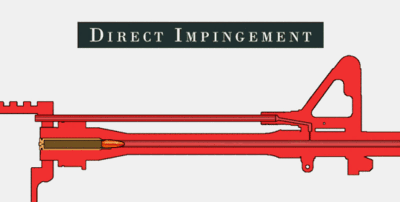- Direct impingement
-
Direct impingement is a type of gas operation for a firearm that directs gas from a fired cartridge directly to the bolt carrier or slide assembly to cycle the action.
Contents
Evaluation
Unlike conventional gas-operated firearms, direct impingement does away with a separate gas cylinder, piston, and operating rod assembly. High-pressure gas acts directly upon the bolt and carrier thereby saving weight, lowering costs, and reducing the mass of the operating parts.
The main disadvantage of direct impingement is that the breech of the firearm becomes fouled more quickly. This is caused by solids from the high-temperature gas condensing on the bolt face and primary operating mechanism. The combustion gases contain vaporized metals, carbon, and impurities in a gaseous state until they contact cooler operating parts. The deposits increase friction on the bolt's camming system leading to jams, so that thorough and frequent cleaning is required to ensure reliability. The amount of fouling depends upon the rifle's design as well as the type of propellant powder used. For example, the French MAS 44 and MAS 49 series of rifles was known to have been successfully operated for years with corrosive-primed ammunition using ordinary field cleaning expedients such as gasoline (as solvent) and straight-grade motor oil (as lubricant).[citation needed] While the 7.62mm Armalite AR-10 proved fairly resistant to malfunctions caused by deposit fouling, the smaller 5.56mm M16A1 experienced significantly increased malfunctions due to fouling and carbon deposits after a change in propellant specifications.
A further disadvantage of direct impingement is that combustion gases heat the bolt and bolt carrier as the firearm operates. This heating may alter the temper of metal parts, accelerating wear and decreasing the service life of the bolt, extractor, and extractor spring. Heat dries up lubricant and makes the operating parts difficult to handle when clearing malfunctions. Heat can also melt the lacquer coatings of steel cartridge cases, gumming up parts. Thermal expansion in the action can result in loss of tolerances and consequent degradation in accuracy.
Conversely, in a conventional gas piston design such as the Armalite AR-18, gas used to operate the firearm is isolated from the breech and contained within the gas cylinder then vented away from other working parts. Some systems actually contain the gas completely and vent excess back into the barrel, such as the M1 Carbine and FN SCAR.
History
The first experimental rifle using a direct impingement system was the French ENT 1901 Rossignol B1 rifle followed by Rossignol's B2, B4 and B5. The first successful production weapon was the MAS 40 rifle adopted in March 1940. The Swedish Ag m/42 is another well-known example. Both the French and Swedish rifles use a simple system whereby the gas tube acts as a piston with a cylinder recess in the bolt carrier.
The premier current example of direct impingement is the AR-15/M16 rifle designed by Eugene Stoner who first designed the Armalite AR-10. In the Stoner system covered by U.S. Patent 2,951,424, gas is routed from a port in the barrel directly to a chamber formed in the bolt carrier. The bolt acts as the piston and is sealed with small automobile-style piston rings.
See also
Bibliography
- Centre des archives de l'armement, Châtellerault. National Armament Archives Center.
- Huon, Jean. Proud Promise—French Semiautomatic Rifles: 1898-1979, Collector Grade Publications,1995,ISBN 0-88935-186-4
References
Categories:- Firearm actions
Wikimedia Foundation. 2010.

